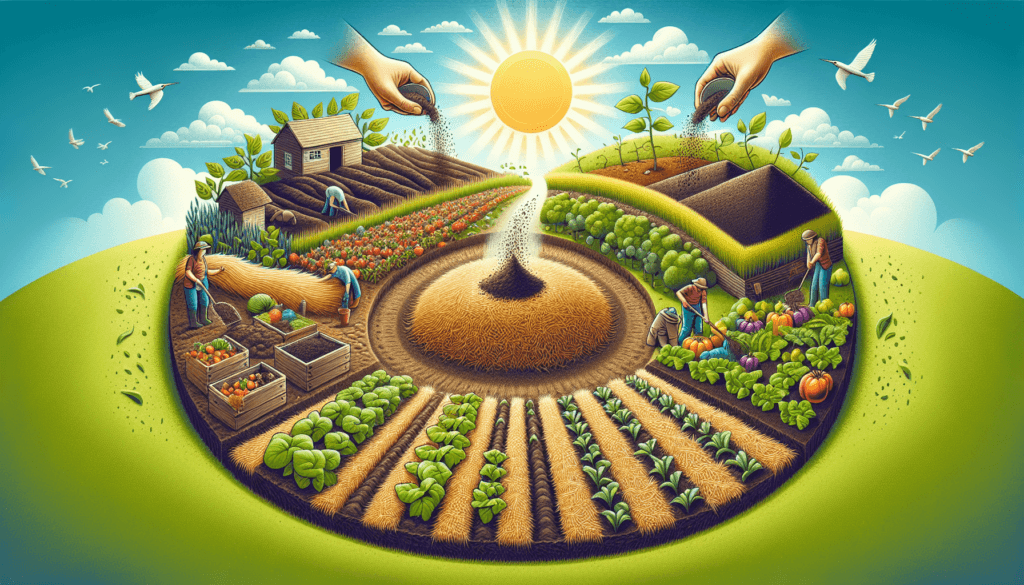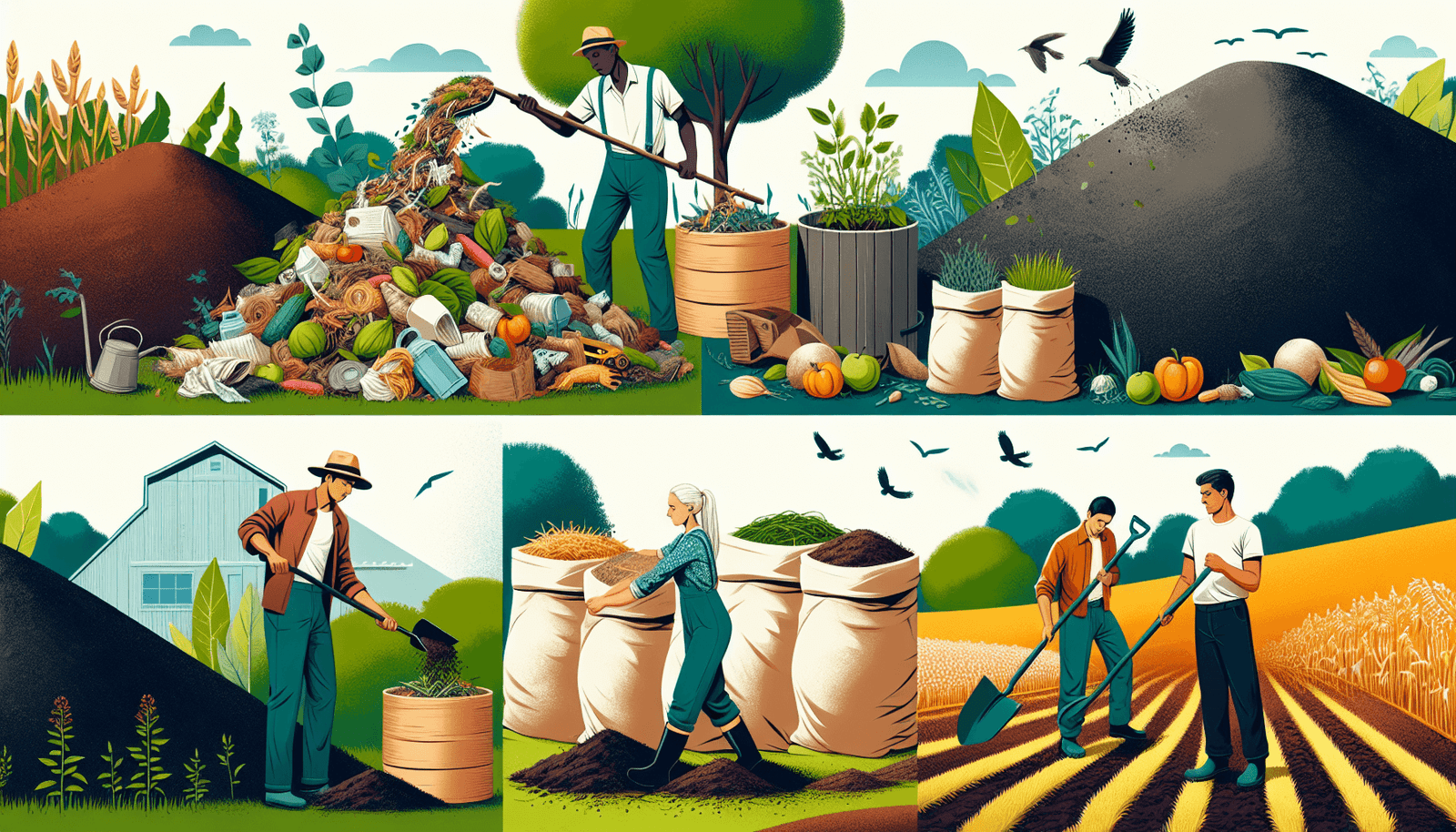Imagine a world where soil is rich and fertile, supporting the growth of healthy crops and lush vegetation. In this article, we will explore a range of eco-friendly solutions for soil enrichment that can help make this vision a reality. From composting and green manure to cover cropping and crop rotation, these sustainable practices will not only improve soil quality but also promote biodiversity and reduce the need for harmful fertilizers and pesticides. Get ready to discover the secrets to nurturing and revitalizing our precious soil in the most environmentally friendly way possible.

1. Composting
1.1 Benefits of composting
Composting is a wonderful way to not only reduce waste but also enrich your soil. By composting organic materials such as food scraps, yard waste, and leaves, you can create nutrient-rich compost that can be used in your garden. One of the main benefits of composting is that it helps reduce the amount of waste that goes to landfills, which in turn reduces greenhouse gas emissions. Additionally, composting improves soil structure, increases water retention, and enhances nutrient availability for plants. It is a natural and sustainable way to nourish your garden while minimizing environmental impact.
1.2 How to make compost
Making compost is a relatively simple process that anyone can do at home. To start, you’ll need a compost bin or a designated area in your yard for composting. Begin by layering brown materials, such as dry leaves or shredded newspaper, with green materials like fruit and vegetable scraps, grass clippings, and coffee grounds. It’s important to maintain a balance between brown and green materials to ensure proper decomposition. Add water to keep the compost moist, but not soggy, and mix the pile occasionally to provide oxygen for the microorganisms that break down the organic matter. Over time, the materials will decompose, and you’ll be left with nutrient-rich compost to use in your garden.
1.3 Composting techniques
There are various techniques for composting, each with its own advantages. Two popular methods include the traditional composting method and vermicomposting.
The traditional composting method involves creating a compost pile or using a compost bin. This method relies on microorganisms to break down the organic matter. It is important to regularly turn the pile to provide oxygen and facilitate decomposition. This technique is effective for larger quantities of organic waste and can produce compost in a few months to a year, depending on the conditions.
Vermicomposting, on the other hand, utilizes worms to accelerate the decomposition process. Red worms, also known as red wigglers, are commonly used in vermiculture. These worms consume the organic matter and produce nutrient-rich castings, also known as worm compost. Vermicomposting is a great option for those with limited space or smaller amounts of organic waste. The process is relatively quick, with compost ready to use in just a few months.
2. Cover Crops
2.1 What are cover crops
Cover crops are plants that are grown specifically to improve soil health and protect it from erosion, rather than for harvest. These crops are typically dense and fast-growing, and they help to prevent nutrient leaching, suppress weeds, and add organic matter to the soil. Cover crops can be grown during periods when the main crop is not in the ground or as an intercrop alongside the main crop. They are a natural and effective way to enhance soil fertility and structure.
2.2 Benefits of cover crops
The use of cover crops offers several benefits to your garden. First and foremost, cover crops help to prevent soil erosion. The dense foliage and the root systems of cover crops anchor the soil, reducing the risk of runoff and loss of valuable topsoil. Additionally, cover crops improve soil structure by increasing its organic matter content and promoting beneficial microbial activity. This, in turn, enhances nutrient cycling and availability for subsequent crops. Cover crops also suppress weed growth by shading the soil and outcompeting weeds for resources such as sunlight and nutrients. By utilizing cover crops, you can minimize the need for synthetic herbicides and reduce the overall weed pressure in your garden.
2.3 Popular cover crops
Several cover crops are popular due to their ability to provide specific benefits to the soil. Some common cover crops include:
-
Winter Rye: This hardy cover crop establishes quickly and offers excellent soil erosion control. It also helps suppress weeds and scavenges nutrients, making them available for other plants.
-
Crimson Clover: Known for its vibrant red flowers, crimson clover is a nitrogen-fixing cover crop that enriches the soil with this essential nutrient. It also attracts pollinators and improves soil structure.
-
Buckwheat: Buckwheat is a fast-growing cover crop that excels at suppressing weeds. Its dense growth shades out weed seedlings and improves soil health by adding organic matter.
-
Hairy Vetch: Hairy vetch is a nitrogen-fixing cover crop that adds fertility to the soil. It is often used in combination with cereal grains to provide a balanced nutrient mix.
By selecting the right cover crops for your garden and implementing them effectively, you can significantly improve soil health and fertility while minimizing the use of synthetic inputs.
3. Crop Rotation
3.1 Importance of crop rotation
Crop rotation is a beneficial technique that involves growing different crops in a specific sequence on the same piece of land over time. This practice helps to break disease and pest cycles, improve soil fertility, and enhance overall crop yield. By rotating crops, you disrupt the buildup of pests and diseases that may be specific to certain crops. This reduces the need for chemical pesticides and promotes a healthier balance in your garden ecosystem. Crop rotation also helps improve soil fertility by preventing the depletion of specific nutrients as certain crops use different nutrients from the soil. Additionally, rotating crops with different root structures can enhance soil structure and water-holding capacity, leading to healthier plants and improved yields.
3.2 How to implement crop rotation
Implementing crop rotation in your garden requires careful planning and consideration. Start by categorizing your crops into different groups based on their taxonomic similarities and their nutrient requirements. Ideally, rotate crops from different groups in a specific order to disrupt disease and pest cycles effectively. For example, avoid planting crops from the same family back-to-back. It is also essential to consider the length of the crop rotation cycle and adjust it based on your specific needs and garden conditions.
When planning your crop rotation, keep in mind the specific needs of different crops, such as sun exposure, soil pH, and water requirements. Consider how each crop will affect the soil, both in terms of nutrient uptake and the impact on soil structure. By carefully designing your crop rotation plan, you can optimize soil health, reduce pest and disease pressure, and maximize the overall productivity of your garden.
4. Mulching
4.1 Types of mulch
Mulching is a technique that involves covering the soil surface with a layer of organic or inorganic material. This layer serves multiple purposes, including weed suppression, moisture retention, temperature regulation, and soil protection. There are various types of mulch available, each with its own benefits.
-
Organic Mulch: Organic mulch includes materials such as straw, wood chips, leaves, and grass clippings. It adds organic matter to the soil as it breaks down, improving soil fertility. Organic mulch also helps regulate soil temperature, conserve moisture, and suppress weed growth.
-
Inorganic Mulch: Inorganic mulch, such as plastic or landscape fabric, does not break down like organic mulch. It effectively suppresses weed growth, conserves moisture, and moderates soil temperatures. Inorganic mulch is especially useful in areas where water efficiency is crucial or when preventing weed competition is a top priority.
-
Living Mulch: Living mulch refers to low-growing plants that cover the soil surface while coexisting with your main crop. Examples include clover or creeping thyme. Living mulch offers similar benefits to traditional mulch, such as weed suppression and moisture retention. Additionally, it can attract beneficial insects and provide habitat for soil organisms.
4.2 Benefits of mulching
Mulching offers several benefits to your garden and soil health. First and foremost, mulch helps suppress weed growth by shading the soil surface and preventing weed seeds from germinating. This reduces competition for resources such as water and nutrients, allowing your plants to thrive. Mulching also helps conserve soil moisture by reducing evaporation, meaning you’ll spend less time watering your garden. Additionally, mulch acts as an insulating layer, protecting the soil from temperature extremes and reducing the risk of erosion.
Furthermore, organic mulch adds valuable organic matter to the soil as it breaks down, enhancing soil fertility and promoting beneficial microbial activity. The improved soil structure resulting from mulching encourages deeper root growth and improved nutrient uptake by plants. By incorporating mulching into your gardening routine, you can create a healthier and more productive garden environment.
4.3 How to mulch effectively
To mulch effectively, start by preparing the soil surface by removing weeds and debris. Ensure that the soil is adequately moist before applying the mulch. Apply a layer of mulch approximately 2-3 inches thick, taking care not to mound it up against the stems or trunks of plants. Leave a small gap around the base of each plant to prevent excess moisture buildup and potential rot. As the mulch decomposes, replenish it as needed to maintain the desired thickness.
It’s important to periodically check the moisture levels under the mulch and adjust your watering accordingly. While mulch helps conserve moisture, it can also act as a barrier that prevents water from reaching the soil if it becomes too thick or compacted. Regularly monitor your plants to ensure they are receiving adequate moisture and adjust your mulching routine as necessary.

5. Vermicomposting
5.1 Introduction to vermicomposting
Vermicomposting is the process of composting organic materials using worms. This method utilizes the natural feeding habits of worms to break down organic waste into nutrient-rich compost known as worm castings. Vermicomposting is an efficient and eco-friendly way to convert kitchen scraps, paper waste, and other organic materials into a valuable soil amendment.
5.2 Setting up a vermicompost bin
To set up a vermicompost bin, you’ll need a container with a lid, such as a plastic or wooden bin. Drill small holes in the lid and sides to allow for ventilation. Place a layer of bedding material in the bottom of the bin, such as shredded newspaper or coconut coir, to provide a comfortable environment for the worms. Next, add the worms to the bin. Red worms, or red wigglers, are commonly used for vermicomposting due to their ability to consume large quantities of organic waste.
Once the worms are settled, begin feeding them with appropriate kitchen scraps and paper waste. Avoid giving them meat, dairy products, oily foods, or citrus peels as these can attract pests or harm the worms. Bury the food waste under the bedding material to prevent odors and fruit flies. Maintain a moist but not waterlogged environment by occasionally watering the bin or adding moist bedding material. Regularly observe the bin to ensure the worms are healthy and active.
5.3 Maintaining a vermicompost bin
Maintaining a vermicompost bin is relatively easy. Harvest the worm castings every few months by separating them from the bedding material. The castings can be used immediately or stored for future use. Take care not to disturb the worms during the harvesting process, as they will be needed to continue the composting process.
Keep an eye on the moisture levels of the bin and make adjustments as needed. If the bin becomes too wet, add dry bedding material to absorb excess moisture. If the bin is too dry, mist the bedding with water. Rotate the feeding areas in the bin to prevent buildup and ensure that the worms have access to fresh food waste.
Vermicomposting is a rewarding process that allows you to convert organic waste into nutrient-rich compost while harnessing the power of worms. With a little care and attention, your vermicompost bin will provide you with a constant supply of valuable soil amendment.
6. Biochar
6.1 What is biochar
Biochar is a highly porous form of charcoal that is made from the incomplete combustion of organic materials, such as wood, crop residues, or manure. This ancient technique of producing charcoal has been used for centuries to improve soil fertility and carbon sequestration. Biochar can enhance soil structure, increase nutrient retention, and promote beneficial microbial activity.
6.2 Benefits of biochar
The use of biochar offers several benefits to soil health and plant growth. Firstly, biochar provides a long-lasting carbon sink, helping to mitigate climate change by sequestering carbon in the soil. This can significantly reduce greenhouse gas emissions and promote sustainable agriculture.
Biochar also improves soil structure by increasing porosity and water-holding capacity. Its porous nature provides a habitat for beneficial microorganisms, promoting nutrient cycling and improving soil fertility. Furthermore, biochar enhances nutrient retention, minimizing leaching and making nutrients more available to plants over time. It can also help neutralize acidic or alkaline soils, creating a more balanced pH level for optimal plant growth.
6.3 How to apply biochar to soil
When applying biochar to soil, it is important to consider the specific needs of your plants and the characteristics of your soil. Start by incorporating biochar into the top layer of the soil, ensuring even distribution. Biochar works best when it is well-mixed with the soil rather than concentrated in certain areas. The application rate will depend on specific soil conditions and your desired outcome, so consult with a local agricultural extension or soil expert for guidance.
To maximize the benefits of biochar, it is recommended to charge it before applying it to the soil. Charging involves pre-treating the biochar with compost, manure, or other organic matter to enrich it with nutrients. This process helps enhance its effectiveness as a soil amendment.
By utilizing biochar in your garden, you can improve soil fertility, sequester carbon, and promote sustainable agriculture practices.

7. Green Manure
7.1 What is green manure
Green manure refers to crops that are grown specifically to be incorporated into the soil while still green, rather than harvested for consumption. These crops add organic matter, nutrients, and other beneficial properties to the soil, enhancing its fertility and structure. Green manure crops are typically fast-growing and have deep root systems that help break up compacted soil and promote better water penetration.
7.2 Benefits of green manure
The use of green manure crops offers numerous benefits for soil health and plant growth. By incorporating green manure into the soil, you can improve its organic matter content, leading to improved soil structure and nutrient availability. The decomposing green manure releases valuable nutrients back into the soil, reducing the need for synthetic fertilizers. Additionally, green manure crops help suppress weeds by shading the soil, preventing weed seed germination, and reducing competition for resources such as water and nutrients. The deep root systems of green manure crops can also help break up compacted soil layers, improving water infiltration and aeration.
Green manure crops also provide habitat for beneficial insects and microorganisms, promoting a healthier garden ecosystem. Some green manure crops, such as legumes, have the ability to fix atmospheric nitrogen, enriching the soil with this important nutrient. Overall, green manure crops are an effective and eco-friendly way to improve soil fertility and structure, reduce weed pressure, and enhance overall plant health.
7.3 Common green manure crops
Several green manure crops are commonly used due to their beneficial properties and ease of incorporation. Here are a few examples:
-
Clover: Clover is a popular choice for green manure due to its nitrogen-fixing abilities and ability to suppress weeds. It is a low-maintenance crop that can be easily incorporated into the soil.
-
Buckwheat: Buckwheat is a fast-growing green manure crop that excels at suppressing weeds and adding organic matter to the soil. Its dense growth and fibrous root system help break up compacted soil.
-
Mustard: Mustard is known for its biofumigant properties, which release compounds that suppress soil-borne pests and diseases. It also adds organic matter and improves soil structure.
By incorporating green manure crops into your garden rotation, you can improve soil fertility, suppress weeds, and promote a healthier and more productive garden environment.
8. Compost Tea
8.1 What is compost tea
Compost tea is a liquid extract made from compost that is used as a foliar spray or soil drench. It is created by steeping compost in water and then aerating the mixture to promote the growth of beneficial microorganisms. Compost tea is a powerful tool for enhancing soil fertility, improving plant health, and suppressing plant diseases.
8.2 How to make compost tea
To make compost tea, start by filling a container with water, preferably dechlorinated or rainwater. Add a generous amount of compost to the water, approximately one part compost to four parts water by volume. Allow the mixture to steep for at least 24 hours, stirring occasionally to promote aeration. After the steeping period, strain the liquid to remove any large particles of compost.
For aerated compost tea, use an aquarium air pump and air stone to introduce oxygen into the mixture during the steeping process. Aeration helps promote the growth of beneficial aerobic microorganisms and enhances the effectiveness of the compost tea.
8.3 Applying compost tea to soil
Compost tea can be applied to the soil in several ways, depending on your specific needs. For soil drenching, simply pour the compost tea directly onto the soil around the root zone of your plants. This helps deliver the beneficial microorganisms and nutrients directly to the roots, improving nutrient uptake and overall plant health.
As a foliar spray, compost tea can be misted onto the leaves of plants using a spray bottle or a backpack sprayer. This method allows the beneficial microorganisms to colonize the plant’s foliage and provide protection against certain plant diseases.
Compost tea is most effective when used as a regular part of your gardening routine. Apply it every few weeks or as needed throughout the growing season to promote healthy plant growth and improve soil fertility.

9. Crop Residues
9.1 Using crop residues as soil amendment
Crop residues, such as the stems, leaves, and roots of harvested plants, can be utilized as a valuable soil amendment. Instead of discarding these residues, you can incorporate them back into the soil to improve its organic matter content, enhance nutrient cycling, and promote the overall health of your garden.
Crop residues add carbon and nutrients to the soil as they decompose, improving soil fertility and promoting beneficial microbial activity. By returning crop residues to the soil, you can help maintain or increase organic matter levels, leading to improved soil structure, water-holding capacity, and nutrient availability.
9.2 Best practices for incorporating crop residues
When incorporating crop residues into the soil, it is important to follow best practices to ensure effective decomposition and nutrient release. Firstly, chop the residues into smaller pieces to speed up the decomposition process. This can be done using a lawnmower, a shredder, or by hand.
Next, incorporate the chopped residues into the soil to a depth of a few inches or bury them underneath a layer of mulch. This helps protect the residues from excessive drying or decomposition, while also aiding in the breakdown process.
It is important to note that some crop residues, such as those from diseased plants, should not be incorporated back into the soil to avoid spreading diseases. Properly dispose of diseased or pest-infested residues to prevent potential contamination.
By effectively incorporating crop residues into the soil, you can recycle organic materials, improve soil fertility, and reduce waste.
10. Natural Amendments
10.1 Examples of natural amendments
Natural amendments are substances derived from natural sources that can be used to improve soil fertility and structure. These amendments are often rich in organic matter, essential nutrients, and beneficial microorganisms. Examples of natural amendments include:
-
Compost: Compost is the result of the decomposition of organic materials, such as kitchen scraps, yard waste, and leaves. It is a rich source of organic matter and nutrients, making it an excellent soil amendment.
-
Bone Meal: Bone meal is made from ground animal bones and is a valuable source of phosphorus and calcium. It is commonly used to enrich soils that lack these essential nutrients.
-
Fish Emulsion: Fish emulsion is a natural fertilizer made from fish waste. It is a good source of nitrogen and other nutrients, making it an effective soil amendment for promoting healthy plant growth.
-
Seaweed: Seaweed is rich in trace minerals and can be used as a soil amendment to improve nutrient availability. It also contains beneficial growth-promoting hormones that can enhance plant growth and root development.
10.2 How to use natural amendments effectively
To use natural amendments effectively, it is important to consider the specific needs of your plants and soil. Start by testing your soil to determine its nutrient levels and pH. This can help you identify any nutrient deficiencies or imbalances that can be addressed with the appropriate natural amendments.
When applying natural amendments, follow the recommended dosages and application instructions provided by the manufacturer. It is important not to overapply amendments, as this can lead to nutrient imbalances or other issues.
Incorporate the natural amendments into the soil thoroughly, either by mixing them into the planting hole or spreading them evenly over the soil surface. Water the soil after application to help the amendments integrate with the soil and make the nutrients available to the plants.
Remember to monitor the health of your plants and soil after application to ensure proper nutrient availability and adjust your amendment routine if necessary.
10.3 Precautions to consider when using natural amendments
While natural amendments can provide significant benefits to soil fertility and plant growth, it is important to consider certain precautions. Some natural amendments, such as manure or bone meal, may have a strong odor or attract pests if not incorporated properly. It is important to handle these amendments with care and follow recommended application practices.
Additionally, some natural amendments, such as seaweed, may contain high levels of salt. In areas with high levels of soil salinity, it is important to moderate the use of seaweed and monitor the salt levels in the soil.
Always read and follow the instructions provided by the manufacturer on the packaging of natural amendments. It’s also advisable to consult with a local agricultural extension or soil expert to ensure proper application and potential interactions with other soil amendments or fertilizers.
By considering these precautions and using natural amendments responsibly, you can improve soil fertility, promote plant health, and cultivate a more sustainable garden environment.
Incorporating eco-friendly solutions for soil enrichment is not only beneficial for your garden but also for the environment. Composting, cover crops, crop rotation, mulching, vermicomposting, biochar, green manure, compost tea, crop residues, and natural amendments all contribute to improving soil health, reducing waste, and promoting sustainable gardening practices. By implementing these techniques and understanding their benefits and proper application, you can create a thriving garden ecosystem that nourishes both your plants and the planet.



